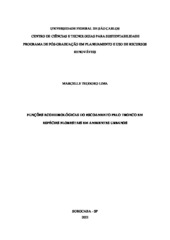Funções ecohidrológicas do escoamento pelo tronco em espécies florestais em ambientes urbanos
Resumo
Trees play an important role in the hydrological cycle and nutrient cycling, playing an important ecosystem function. Even though it represents a small proportion of total precipitation, the stemflow has a significant ecohydrological contribution to the environment, providing the soil with additional amounts of water and nutrients. This study aims to present the ecohydrological roles of the stemflow of trees belonging to urban areas, in order to verify its chemical, hydrological and microbiotic contribution to the soil. As a method, a systematic review of the literature was initially carried out based on the selection of the most relevant articles on stemflow and nutrient fluxes. Then, the experiment was carried out at the Federal University of São Carlos, campus Sorocaba, São Paulo. During the period from October 2019 to September 2020, rainfall and stemflow were monitored in eight (8) forest species present in an urban environment, together with the study of factors influencing stemflow, such as dendrometric characteristics and morphological species; the abundance and transport of metazoans; the nutrient fluxes; and the change in chemical properties of soils at the base of trees. The results of this study show that research on the effect of stemflow on biogeochemical cycling and soil dynamics remains scarce and full understanding still requires many additional studies. In general, it was proven that the stemflow is an important means for the nutritional maintenance of the tree itself and its vegetal surroundings, being an important process for urban afforestation. It was observed that the yield of stemflow of the analyzed species had different influences from dendrometric and morphological characteristics, in addition to being able to transport metazoa to the soil and not necessarily high volumes of stemflow the trunk correspond to its greater abundance and transport. The same was observed for the nutrient fluxes, in which the enrichment in the stemflow water of the species showed its function as a nutrient source for the soils close to the base of the trees for most of the analyzed ions. In this way, the existence of the ecohydrological functions of the stemflow , adding water, nutrients and microorganisms in the soils in urban environments.
Collections
Os arquivos de licença a seguir estão associados a este item:

